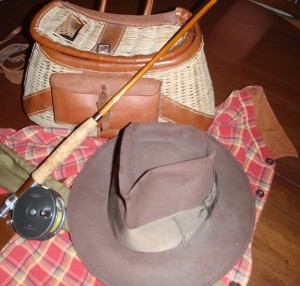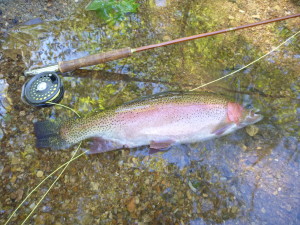
A Payne 205 rod made in the 1940s goes nicely with a Hardy Perfect reel.
The hat, of the same vintage, belonged to my grandfather.
Why Fish With Yesterday’s Tackle?
A century ago, the split cane rod by makers like Payne, Edwards, Leonard, Hardy and Thomas was at the pinnacle of sport-fishing technology, along with fine reels crafted by companies like Leonard, Hardy and Vom Hofe. Strong demand and innovation led to what is sometimes called the Golden Age of bamboo rodmaking, spanning the period from just before World War I to just after World War II. Bamboo became the standard material for fishing rods, and various makers perfected the craft, producing a wide range of rods from cheap (less than a dollar in some cases) to fine, up to $100 in contemporary dollars. The vast majority of rods, tens of thousands, fell in the middle – “production” rods that cost from $20 to $40 and were used by thousands of fishermen, often made and labeled for department stores and hardware stores by major rod companies of that era like Montague, Heddon, South Bend and Granger.
Advances in materials like fiberglass, graphite and metals have brought lighter, faster and stronger rods and reels, but I believe the resulting loss of an organic connection, and perhaps of some of the art and romance, outweighs many of those benefits.
Many of these fine old rods and reels – even the production rods – were so well made that they are still in use today. The best have also been endlessly copied, and sometimes improved upon, so that modern variations and offspring are being made all over the world.
Today, even many people who prefer to fish with the most up-to-date equipment recognize the classic elegance of bamboo rods and of reels that epitomize the durable, impeccably engineered quality of the Industrial Revolution.
To fish with this equipment is a special privilege. Not many tools or machines remain fully functional 50 to 125 years after they were built.
Some collectors are enthralled by the organic nature of bamboo rods, going so far as to talk about “spirits” or “mojo.” It doesn’t hurt that trout are beautiful fish that often live in beautiful places. Add to that the concept of a connection reaching from roots of the bamboo to the fish in the water, with the angler’s hand in the middle, and the discussions can get pretty deep — and pretty silly.
The most important thing to me is that a bamboo rod and classic reel are the best way to enjoy a sport that is all about enjoyment.
